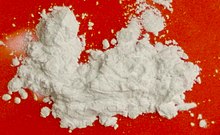
Back أكسيد الزركونيوم الرباعي Arabic دیاوکسید زیرکونیوم AZB Diòxid de zirconi Catalan Oxid zirkoničitý Czech Цирконий(IV) оксичĕ CV Zirconium(IV)-oxid German Dióxido de zirconio Spanish Tsirkooniumdioksiid Estonian دیاکسید زیرکونیوم Persian Zirkoniumdioksidi Finnish

| |

| |
| Names | |
|---|---|
| IUPAC names
Zirconium dioxide
Zirconium(IV) oxide | |
| Other names
Zirconia
Baddeleyite | |
| Identifiers | |
3D model (JSmol)
|
|
| ChemSpider | |
| ECHA InfoCard | 100.013.844 |
| EC Number |
|
PubChem CID
|
|
| UNII | |
CompTox Dashboard (EPA)
|
|
| |
| |
| Properties | |
| ZrO 2 | |
| Molar mass | 123.218 g/mol |
| Appearance | white powder |
| Density | 5.68 g/cm3 |
| Melting point | 2,715 °C (4,919 °F; 2,988 K) |
| Boiling point | 4,300 °C (7,770 °F; 4,570 K) |
| negligible | |
| Solubility | soluble in HF, and hot H2SO4 |
Refractive index (nD)
|
2.13 |
| Thermochemistry | |
Std molar
entropy (S⦵298) |
50.3 J K−1 mol−1 |
Std enthalpy of
formation (ΔfH⦵298) |
–1080 kJ/mol |
| Hazards | |
| GHS labelling: | |

| |
| Warning | |
| H315, H319, H335 | |
| P261, P264, P271, P280, P302+P352, P304+P340, P305+P351+P338, P312, P321, P332+P313, P337+P313, P362, P403+P233, P405, P501 | |
| Flash point | Non-flammable |
| Lethal dose or concentration (LD, LC): | |
LD50 (median dose)
|
> 8.8 g/kg (oral, rat) |
| Safety data sheet (SDS) | MSDS |
| Related compounds | |
Other anions
|
Zirconium disulfide |
Other cations
|
Titanium dioxide Hafnium dioxide |
Except where otherwise noted, data are given for materials in their standard state (at 25 °C [77 °F], 100 kPa).
| |
Zirconium dioxide (ZrO
2), sometimes known as zirconia (not to be confused with zircon), is a white crystalline oxide of zirconium. Its most naturally occurring form, with a monoclinic crystalline structure, is the mineral baddeleyite. A dopant[clarification needed] stabilized cubic structured zirconia, cubic zirconia, is synthesized in various colours for use as a gemstone and a diamond simulant.[1]
- ^ Wang, S. F.; Zhang, J.; Luo, D. W.; Gu, F.; Tang, D. Y.; Dong, Z. L.; Tan, G. E. B.; Que, W. X.; Zhang, T. S.; Li, S.; Kong, L. B. (2013-05-01). "Transparent ceramics: Processing, materials and applications". Progress in Solid State Chemistry. 41 (1): 20–54. doi:10.1016/j.progsolidstchem.2012.12.002. ISSN 0079-6786.
© MMXXIII Rich X Search. We shall prevail. All rights reserved. Rich X Search